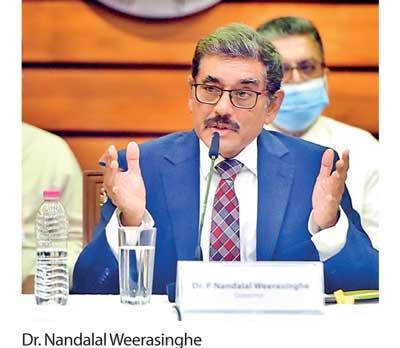04 May 2022 - {{hitsCtrl.values.hits}}
Diffusing certain reports in the media and concerns among the people on the banking sector, the Central Bank last week reassured the stability of the country’s banking sector, citing its robust capital and liquidity profile.
 A statement made in reference to the state lender People’s Bank by Opposition legislator Dr. Harsha de Silva a few weeks ago sparked widespread anxiety among the public about the stability of the country’s banking system.
A statement made in reference to the state lender People’s Bank by Opposition legislator Dr. Harsha de Silva a few weeks ago sparked widespread anxiety among the public about the stability of the country’s banking system.
Alluding to such statements, some irresponsible new reports in the media and rumours, Central Bank Governor Dr. Nandalal Weerasinghe gave his assurance about the stability of the sector.
“Some of the statements made by the politicians are very inappropriate and not relevant at all,” Dr. Weerasinghe said in response to a question by a reporter.
“If you look at the current Sri Lanka’s banking sector, it remains very stable in terms of capital adequacy and other indicators,” he added.
While the banking sector is facing some stress in foreign currency liquidity, as a result of the balance of payment crisis faced by the country since the second half of the last year, Sri Lanka’s banking sector’s rupee liquidity has no issue whatsoever.
Even when there are signs of one, the Central Bank has the tools to backstop such liquidity stresses.
“Obviously the issue right now is the foreign currency liquidity. In the sector, there is a shortage of foreign currency liquidity at different levels,” Dr. Weeraisnghe said.
This is “very different from rupee liquidity,” he added.
According to Dr. Weeraisnghe, while the state banks face higher liquidity shortages, the private banks also confront the same issue to a certain extent.
“That is why I want to give the assurance and make it very clear. In terms of rupee liquidity, the Central Bank, under the Monetary Law Act (MLA), has provisions to provide any amount of liquidity when there is a shortfall in the banking system,” he explained.
While the Central Bank through its daily open market operations provides liquidity to the banking system, in extreme cases, it can pump money through a tool known as ‘lender of last resort’.
To reflect the capital heft and liquidity strength of the banking sector, the data through 2021-end showed that the sector’s Tier I and Tier II capital adequacy ratios were at 13.2 percent and 16.5 percent, respectively, compared to 12.9 percent and 16.2 percent, respectively by the end of the third quarter.
Meanwhile, the liquidity level measured through the statutory liquid assets ratio stood at 30.9 percent in the domestic banking unit, whereas the regulatory minimum was 20 percent.
While the capital buffers would wear thin, sector analysts are of the opinion that most banks might be able to withstand the stresses on their capital profiles, even under a worst-case scenario of debt restructuring, which could happen this year.
However, stresses could mount from the area of asset quality, as soaring rates could push many small to medium-sized borrowers into default, while the earnings could come under pressure when the growth is expected to subdue in 2022 and 2023.
15 Nov 2024 38 minute ago
15 Nov 2024 40 minute ago
15 Nov 2024 52 minute ago
15 Nov 2024 1 hours ago
15 Nov 2024 2 hours ago